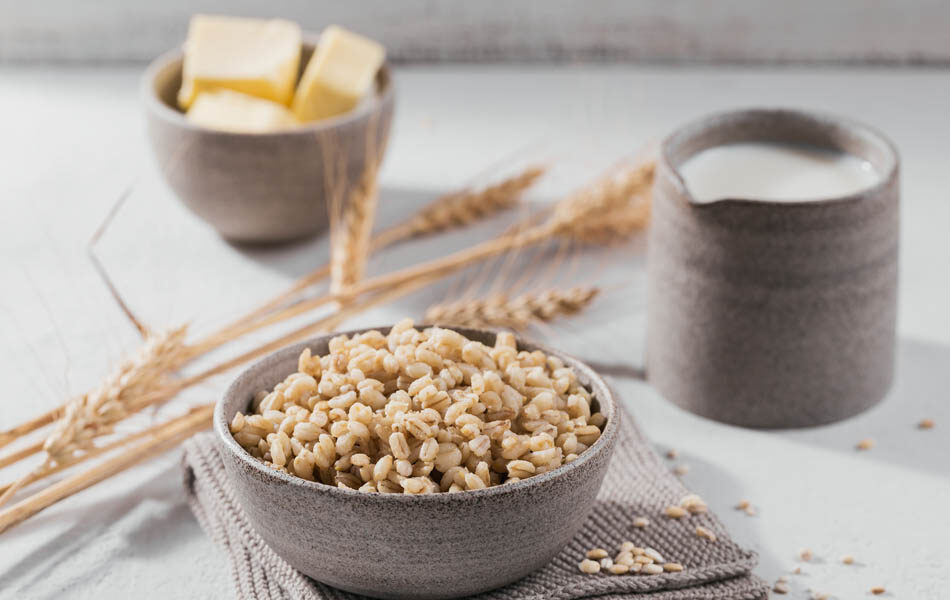Is Barley Good for Diabetes? Reviewing the Cereal Grain
People cook with barley for countless dishes, from soups and stews to bread and grain bowls. If you have diabetes, you need to know more about a particular food than what recipes it works well with. Here, we discuss whether barley is a yes or no for your diabetes-diet grocery list.

Whole grains, like barley, are a staple food around the world. They are loaded with dietary fiber and other essential nutrients that support human health. According to dietary guidelines, these grains should make up at least half of the grains in a balanced diet.
Barley has many health benefits, thanks to its nutritional content. It is an absolutely healthy addition to the average diet and may reduce the risk of cardiovascular diseases. The big question for people with type 2 diabetes is how barley affects blood sugar control.
Keep reading this article to uncover the role of barley in a diabetes meal plan.
Is Barley Good for Diabetes?
Yes, barley is an excellent choice of whole grain for people with diabetes. It contains a plentiful dose of dietary fiber, which slows digestion and helps lower blood sugar and insulin levels. Barley grains have a high amount of the soluble fiber beta-glucan, which may improve glycemic control.
Whole grains tend to fit well with a diabetes diet because they are high-fiber foods, whereas most fiber and nutrients are removed from refined grains. Whole-grain barley is especially nutritious as it is higher in fiber, vitamins, and minerals.
As the body cannot digest fiber, eating fiber-rich foods improves blood sugar control and helps you feel full for longer. You can eat your usual volume of food without taking in excess calories contributing to weight gain.
These beneficial factors support weight loss and weight management for people with diabetes at greater risk of cardiovascular disease. Losing even a small amount of weight can improve blood glucose levels, increase insulin sensitivity, and lower blood pressure.
The absorption of carbohydrates in barley and the conversion into blood sugar is slow compared to other carb-rich foods. This helps your body sustain energy and cellular function without increasing blood sugar levels.
Does Barley Raise Blood Sugar?
Barley has a low glycemic index and does not raise blood sugar levels quickly or significantly. Although barley has a high amount of carbohydrates, it contains lots of soluble fiber, which reduces its glycemic index. Many of the health benefits of barley come down to its fiber content.
The beta-glucan fiber, in particular, slows the absorption of sugar into the bloodstream as it binds to water in the digestive tract, forming a gel-like substance. Soluble fiber can also help control your cholesterol, which contributes to managing diabetes complications.
Nutritional Value of Barley
Bear in mind that the nutritional content of barley differs slightly between varieties. For example, pearled barley, or pearl barley, has fewer nutrients than whole-grain barley or uncooked hulled barley. Hulled barley is the healthiest form and the best for a diabetes diet.
Regardless of the type you purchase, barley remains a remarkably healthy grain. It has a rich nutritional profile with all essential macronutrients and an abundance of micronutrients. It contains some of the best vitamins for diabetes and is low in sugar, fat, and cholesterol.
Below you can discover the nutritional value of pearled barley per 100 grams.
| Net Carbs | Total Carbs | Fats | Protein |
| 62.1g | 77.7g | 1.16g | 9.91g |
| Calories | Fiber | Sugars | Glycemic Index |
| 352 | 15.6g | 0.8g | 28 |
Glycemic Index of Barley
The glycemic index of barley is 28, making it a low glycemic food. Barley has the lowest glycemic score of all the whole grains, including bulgar, buckwheat, and brown rice. Low GI diets help improve glycemic control and keep your blood glucose content in check.
Whole grains tend to have a lower glycemic index and fit well with a diabetes diet, whereas refined grains are digested quickly and typically have a higher glycemic score. Those with a higher score are not ideal for people with diabetes as they cause sharp blood sugar spikes.
How to Use Barley for Diabetes?
As a versatile product, adding barley into your diabetes diet is super easy. Barley has a chewy texture like rice and a slightly nutty flavor that matches many ingredients. For maximum nutrition, it’s best to opt for whole-grain barley.
To get more barley into your eating plan, you can substitute it for major cereal grains, like rice and wheat. Cooked barley makes a great base for soups and stews and works just as well on its own as a side dish. You can also cook barley and add it to your salads and vegetable dishes.
Rather than eating refined wheat bread, you can replace wheat flour with barley flour in bread recipes. Whole-wheat bread is nutritious, but it may spike blood sugars. Barley flakes make a tasty breakfast porridge as an alternative to rolled oats.
Drinking barley water is another way of consuming barley. Unsweetened barley water contains antioxidants and is an excellent beverage for people with diabetes.
4 Benefits of Barley for Diabetes You Should Know About
So far, we’ve touched on some of the major perks of including barley in your diabetes diet. Let’s look at the other health benefits of barley to see how it may contribute to diabetes management.
#1 Promotes intestinal health
Barley is a major contributor to a happy gut. Fiber is critical for proper digestion and regular bowel movements. The high-fiber content can improve digestion as it helps move waste along the intestine more quickly.
It also softens and bulks the stool, making it easier to pass and preventing irregular bowel movements and the many other downsides associated with constipation.
Barley consumption promotes healthy gut bacteria in the digestive tract by increasing the presence of good bacteria. Soluble fiber sources like barley may benefit certain bowel disorders, such as inflammatory bowel disease and ulcerative colitis.
#2 Reduces blood pressure
Consumption of barley may lower systolic and diastolic blood pressure. People with diabetes are twice as likely to have high blood pressure as diabetes can cause damage and hardening of the arteries. This increases the pressure and makes blood flow more difficult.
Untreated hypertension can lead to heart attack and stroke. It is important to find ways to lower blood pressure and reduce the risk of cardiovascular events in people with diabetes.
#3 Source of antioxidants
Barley has lots of antioxidants with powers that protect against cellular damage caused by oxidative stress. Beta-carotene, lutein, and zeaxanthin are among the antioxidants present in barley. These carotenoids are all excellent for eye health and boosting the immune system.
#4 Good for your heart
Barley is a heart-healthy food.
The soluble dietary fibers reduce some primary risk factors for heart disease, like lowering high blood pressure and reducing high cholesterol and postprandial blood glucose. Barley contains essential minerals that also protect the health of your heart.
For instance, magnesium supports a healthy heart rhythm, and higher intake is associated with a decreased risk of cardiovascular disease.
FAQs
Barley and barley water contains vitamins and minerals, like calcium, magnesium, iron, and zinc, that support the health and function of the kidneys. Barley beta-glucans may reduce inflammation and renal injury and help get rid of kidney stones.
Eating barley supports blood sugar management and may lower blood sugar and insulin levels. The beta-glucan fiber content in barley slows down the absorption of sugar into the bloodstream, helping to keep blood glucose levels under control.
As a grain containing gluten, people with celiac disease or gluten intolerance should not eat barley. Although dietary fiber is encouraged for people with irritable bowel syndrome, whole-grain foods with gluten, like barley, may aggravate symptoms in some people.
A Word From Our MD
Barley is high in fiber and low on the glycemic index – two amazing elements for diabetes. Its mild taste makes it a suitable match for many dishes. You can switch between hulled or pearl barley for a difference in textures.
Whole grains, in general, are great for people with type 2 diabetes. Low GI foods support better glycemic control than refined carbohydrate foods. You can eat plenty of them without triggering hyperglycemia, and they make a staple part of a plant-based diet.
Healthy eating is a priority for diabetes and a non-negotiable method of treatment. You should speak to a medical health professional before changing your diet.
Conclusion
It’s safe to say that barley is a great addition to a diabetes-friendly diet. While consuming barley will not cure the condition, it provides many advantages that make its management easier. Overall, barley helps regulate blood sugars, improves heart health, and promotes appetite control and weight loss. So, it’s a yes from us!

















































 Select your language:
Select your language: 








